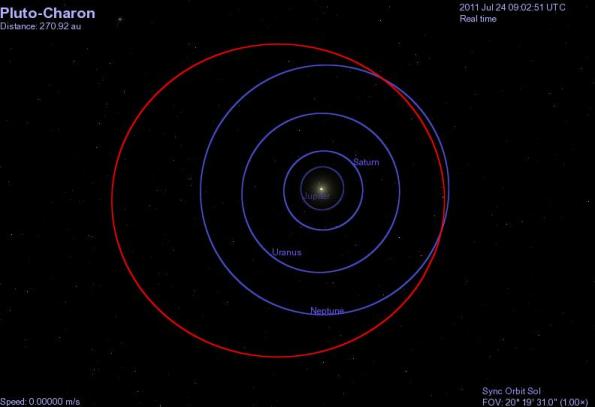Archive
Eight, not nine.
That is the number of planets in our Solar System. I know we have all been taught that there are nine planets. That is what the CBSE, still says, as can be seen from page 22 of this activity book. But in 2006, the International Astronomical Union(IAU) decided to remove Pluto from the list of planets thereby officially reducing the number of planets to eight. Pluto is now only a dwarf planet. Let us see what the IAU had against Pluto.
Pluto was discovered in 1930, more than 85 years after the discovery of the previous planet, Neptune. But Pluto has always been an oddity in the list of planets. For one thing, its orbit was weird.
From the top view, you can see how Pluto’s orbit crosses Neptune’s orbit. No other planet has an orbit like this. So, there are times when this planet is closer to the Sun than the Neptune.
But that is not all. If by the previous paragraph, you were wondering, why Neptune and Pluto with criss-crossing orbits, did not collide into each other, there is another oddity of Pluto that is hidden when seen from the top. The problem is that while orbits of all the other planets lie almost on the same plane, the orbit of Pluto alone, is tilted by about 17 degrees. Look at the two side-on pictures below, to see what I am saying.

Looking at the orbits along plane of revolution of the Pluto's orbit. The orbits of the eight planets appear tilted.
The other thing odd about it was, that the 8 planets discovered so far, fell into two families. The 4 planets closer to the Sun: Mercury, Venus, Earth and Mars, were rocky planets. They were made mostly of rock and metal and hence were called Terrestrial planets. The next 4 planets: Jupiter, Saturn, Uranus and Neptune were primarily made of gases. These latter 4 planets are also referred to as gas giants. Pluto was made of rock and ice, but it did not belong to the family, its neighbour Neptune belonged to.
But what most embarrasses Pluto is its ridiculous size. Look at this picture from NASA.

Planets and other objects, scaled to size. Pluto is just barely visible. Note that the distances are not scaled.
It is so small, that its mass is less than one-fifths of that of our moon. Of course, mere difference in size would not have been much of a problem, since the Earth too is puny, when compared to Jupiter. But Pluto’s moon, Charon, was discovered in 1978 and it was half of the size of Pluto itself (Pluto now has four moons). For contrast, the size of our own Moon is 2% of that of the Earth. Soon many other bodies were discovered beyond Neptune, having sizes comparable to that of Pluto. This made astronomers realise that Pluto did not belong to the planets, but was part of a different group whose members were being rapidly discovered. Finally the worst happened. Eris was discovered in 2005.
Eris is a celestial body which orbits the Sun, and its mass is 25% more than that of Pluto. This was the first object discovered orbiting the sun that was more massive than Pluto (of course, apart from the other 8 planets). This posed a dilemma. Either Eris should be added as a planet, and along with it many other bodies, or drop Pluto from the list of planets. The definition of what actually constitutes a planet, became crucial, and hence in 2006, the IAU met, to decide on a formal definition. In that meeting, the IAU laid down the following as the eligibility criteria for a planet. From wikipedia:
The definition of planet set in 2006 by the International Astronomical Union (IAU) states that in the Solar System a planet is a celestial body that:
- is in orbit around the Sun,
- has sufficient mass to assume hydrostatic equilibrium (a nearly round shape)
- has “cleared the neighbourhood” around its orbit.
The first 2 points are clear and Pluto satisfied both. But the third one was its undoing. What the third rule means is that the body should be the dominant (in terms of mass) object in its vicinity. This Pluto was definitely not, since similar sized objects were present near it. Thus Pluto lost its status as a Planet. Pluto joined the group called dwarf planets, in which it is the second largest, with Eris being on top.
Interestingly, the whole debate was sparked off, when a planetarium in New York (Hayden Planetarium) prepared an exhibit in 2000, with only eight planets, leaving out Pluto. The brain behind this was its director, Neil De Grasse Tyson. Here is what wikipedia says about him.
As director of the Hayden Planetarium, Tyson bucked traditional thinking to keep Pluto from being referred to as the ninth planet in exhibits at the center. Tyson has explained that he wanted to look at commonalities between objects, grouping the terrestrial planets together, the gas giants together, and Pluto with like objects and to get away from simply counting the planets.
Neil Tyson is an amazing science communicator. His interest science and his enthusiasm in communicating both make him a tremendous person. I recently saw a video of his. A must-watch. It was informative, and absolutely hilarious. Here is the video for you. His talk (more of an interview) starts 15 minutes into the video and goes on for 1 hour. Trust me. You wont regret the time spent watching the video. Look out for the last point he makes in his talk. It is disturbing, but also fascinating.
Note: I got the first three pictures from a free simulation software, Celestia. I recommend you too download and install it. It is fun.

